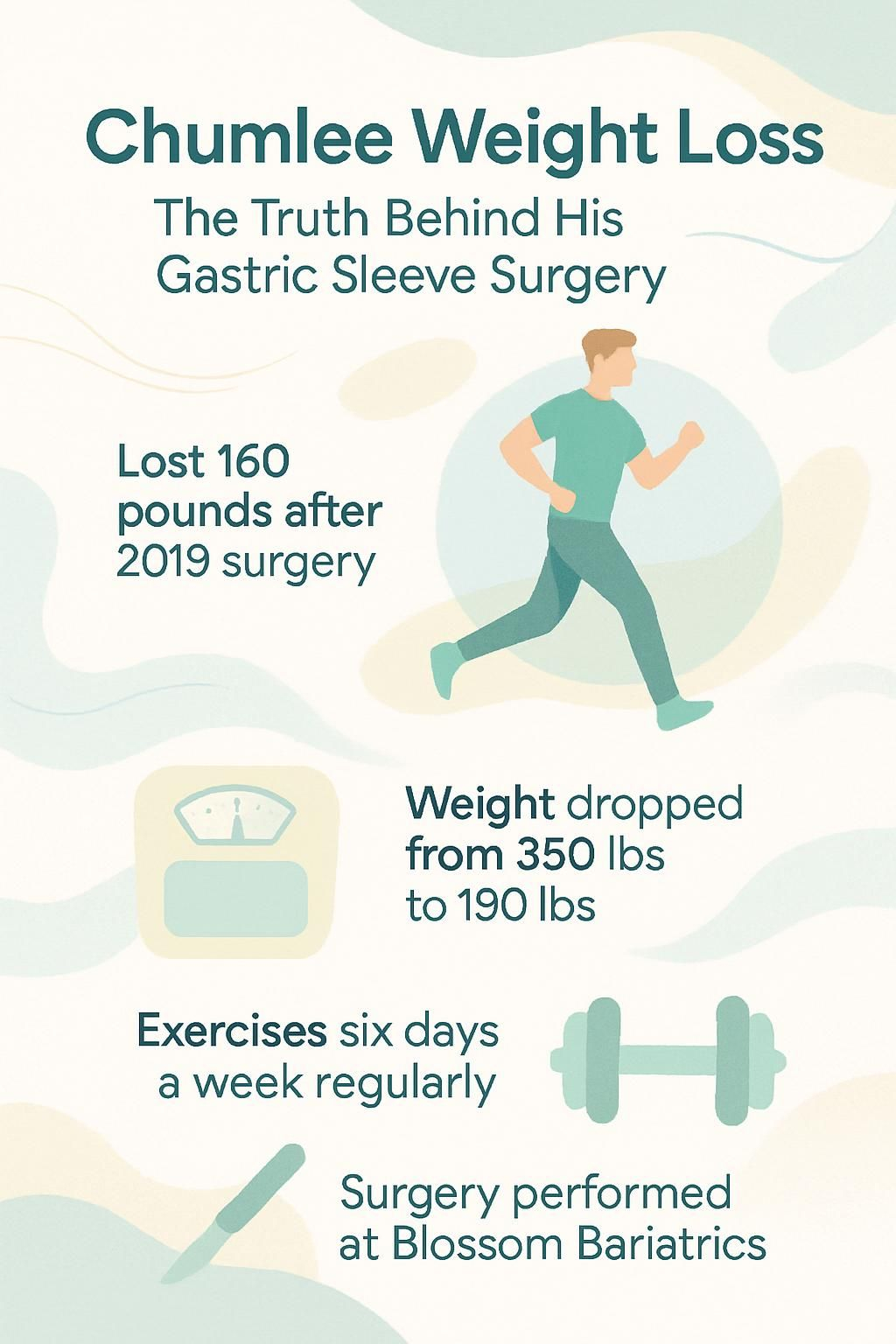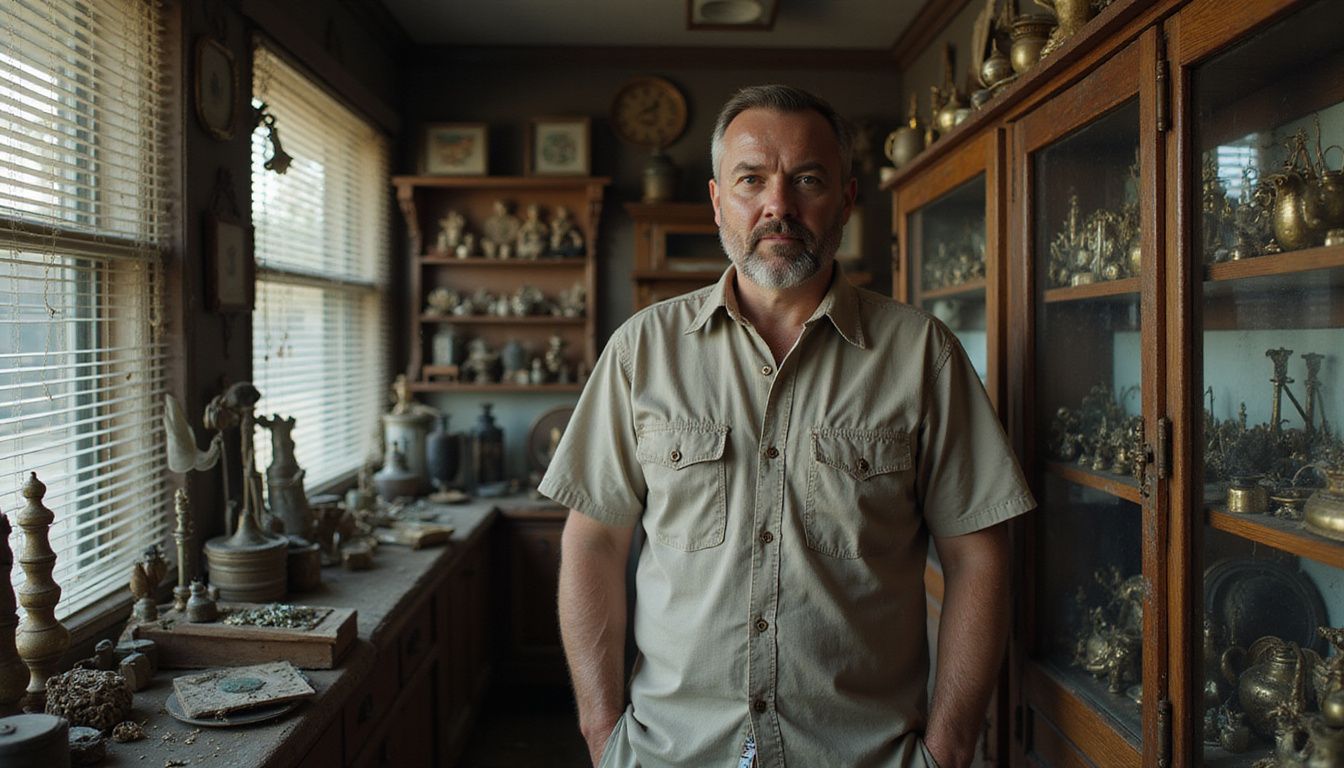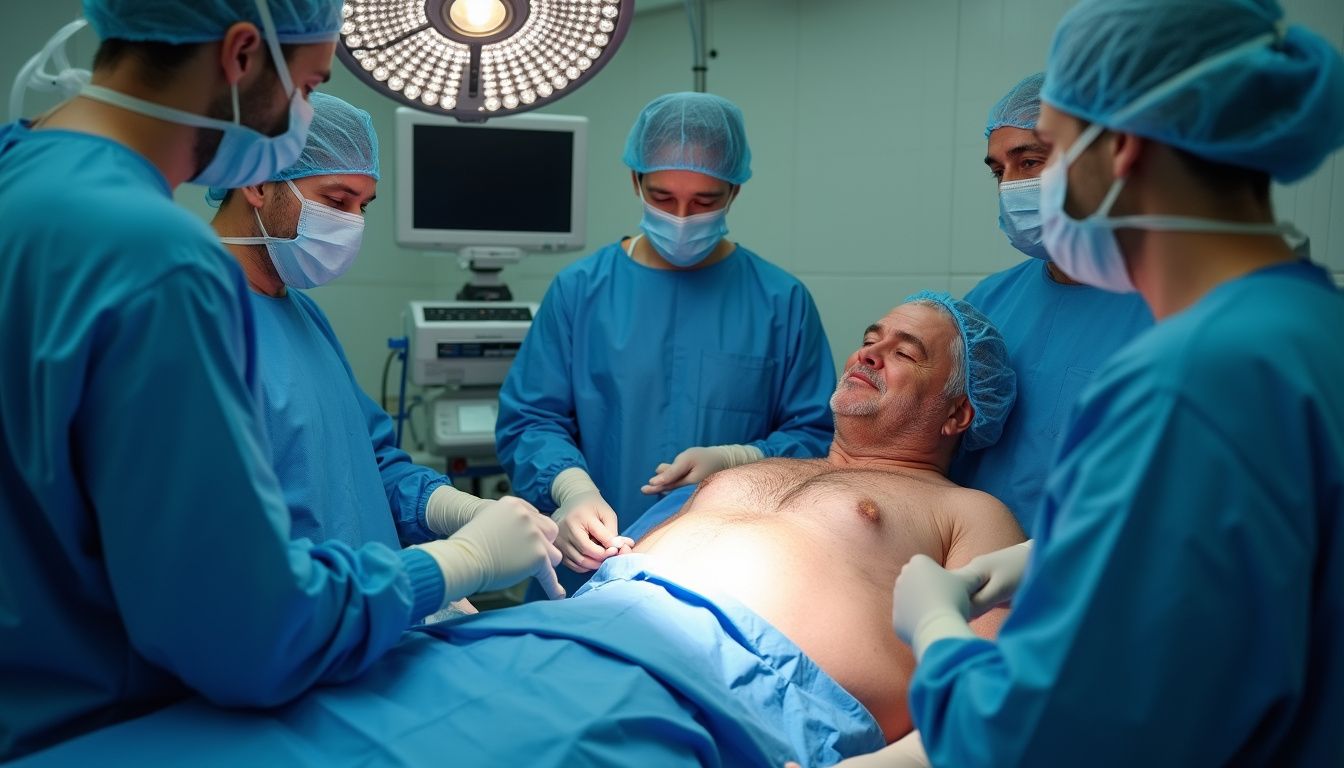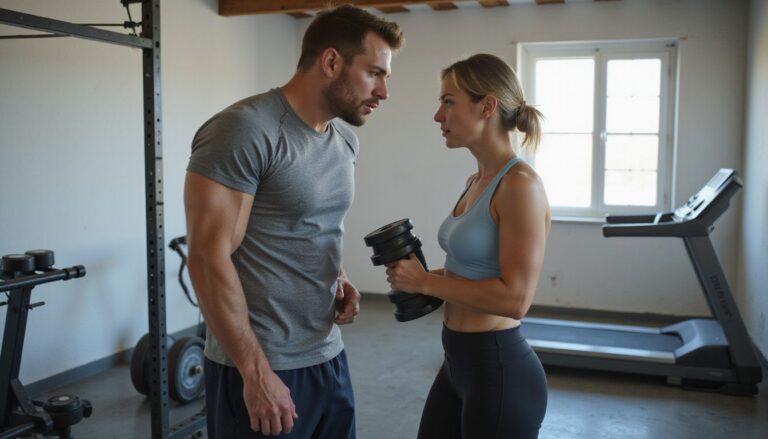Chumlee Weight Loss: The Truth Behind His Gastric Sleeve Surgery
Our Nutrition Assistant AI Suite will transform your body. You will lose fat, get toned, and build muscle. Gain confidence and optimal health.
If you have struggled with weight and want real examples, Chumlee’s weight loss story can help. The Pawn Stars favorite chose gastric sleeve surgery, a type of bariatric surgery that shrinks the stomach, and dropped about 160 pounds with care from Blossom Bariatrics in Las Vegas.
This article shares clear facts about his choices, the medical steps involved, and the habits that helped him keep the weight off. You will see how support, expert guidance, and steady routines can make change possible for everyday people.
Key Takeaways
- Chumlee, from the History Channel show Pawn Stars, lost about 160 pounds after gastric sleeve surgery with Dr. Matt Apel at Blossom Bariatrics in Las Vegas in 2019.
- His weight decreased from a peak of 350 lbs in January 2019 to 190 lbs by October 2021, lowering risks like diabetes and heart disease.
- Clean eating, six days a week of exercise, and strong support from family, friends, and fans helped him keep the weight off.
- The Blossom Bariatrics team guided safe surgery, recovery, and long-term follow up, which supported lasting health gains.
- Public accountability, steady routines, and medical advice were critical to Chumlee’s long-term weight loss success.

Who Is Chumlee?

Chumlee, whose name is Austin Lee Russell, became a TV personality through the History Channel series Pawn Stars. Viewers watched him work at the Gold and Silver Pawn Shop in Las Vegas, and many noticed his long struggle with excess weight.
What Is Chumlee’s Background and Career?
Austin Lee Russell grew up in Nevada and joined the Gold and Silver Pawn Shop as a teen. Working with Corey Harrison and Rick Harrison, he learned the trade and became a familiar face to fans across the United States.
His humor and down-to-earth style made him popular on Pawn Stars. Media coverage and social posts on platforms like Instagram and TMZ interviews brought attention to his health over time. With fame came interest in his lifestyle, which made his weight journey very public.
How Has Chumlee Struggled With His Weight?
His weight went up and down for years, sometimes by 100 pounds. In January 2019, he reached 350 lbs. He tried diets and gym plans but could not keep results steady.
He talked openly about the challenge and how hard it felt to maintain progress. Many people shared similar stories with him online, which helped him feel less alone.
I know how hard it is fighting your own body, Chumlee wrote on social media.
The attention from being “Pawn Stars Chumlee” added stress, which often made healthy routines tougher to follow.
Chumlee’s Decision to Make a Change
Lasting change often starts with one clear decision. For Chumlee, that moment came after years of health concerns and stalled attempts.
What Motivated Chumlee to Lose Weight?
Doctors warned him that staying near 350 lbs could lead to conditions like diabetes and heart disease. He wanted a longer, healthier life and more energy for daily work and family time.
Seeing the scale jump for years pushed him to act. After early weight loss, he felt proud, then decided to seek medical help to keep the progress going. That choice led to consultations about gastric sleeve surgery.
Who Supported Chumlee and How Did He Stay Determined?
Family and close friends backed his plans and helped him build new routines. A strong online community also kept him motivated. His Facebook posts about clean eating and workouts drew 38,000 reactions, 3,000 comments, and 536 shares.
He used public updates to stay accountable. Sharing milestones and setbacks made it easier to keep going through hard weeks, even when he saw the scale move between 250 lbs and 190 lbs at different times.
Chumlee’s Gastric Sleeve Surgery
Medical tools can open the door, and daily habits keep it open. Gastric sleeve surgery set the stage for new patterns that fit his goals.
Understanding Gastric Sleeve Surgery
Gastric sleeve surgery, also called sleeve gastrectomy, is a procedure that removes most of the stomach. Surgeons shape the remaining part into a narrow tube, which reduces appetite and limits portion size.
It is now one of the most common bariatric procedures in the United States, according to UCLA Health. The surgery supports weight loss, but it still requires lifelong changes to eating and activity.
This information is educational and not medical advice. Talk with a licensed clinician to decide if surgery is right for you.
Reasons Chumlee Chose Gastric Sleeve Surgery
Years of yo-yo results, rising health risks, and a peak of 350 lbs led him to consider surgery. A medical review showed that sleeve gastrectomy could help him control portions and hunger better than diets alone.
He wanted to protect his heart, joints, and long-term health. Hearing success stories from others and support from loved ones made the decision easier.
Blossom Bariatrics’ Role in Chumlee’s Surgery
Blossom Bariatrics in Las Vegas handled his procedure, with award-winning surgeon Dr. Matt Apel leading the operation. The clinic provides full support, including pre-op education, surgery, and follow-up care.
Patients often feel nervous before major surgery. Staff members guide them step by step so they know what to expect and how to recover safely.
Chumlee’s Post-Surgery Transformation
Change showed up fast, then continued with steady habits. Fans noticed not only the weight loss, but a new way of living.
How Much Weight Has Chumlee Lost?
He lost more than 160 pounds after his gastric sleeve surgery. His weight dropped from 350 lbs in January 2019 to 190 lbs by October 2021.
That is nearly half of his body weight. Medical care at Blossom Bariatrics and daily routines made the difference, and many fans were surprised by the dramatic change.
What Health and Lifestyle Changes Has He Experienced?
Weight loss changed nearly every area of his life. The biggest shifts involved food, movement, and support systems.
- Chumlee lost over 160 pounds, which eased pressure on his knees, hips, and back.
- Blood pressure and cholesterol markers improved after surgery and healthy habits.
- He cut sugar and processed snacks, which helped control cravings and energy dips.
- Meals now center on vegetables, lean protein, and balanced portions to protect muscle and support fat loss.
- Regular workouts, including cardio and strength training, became part of his weekly schedule.
- Family, friends, and his care team provided motivation during tough weeks.
- Sharing progress online brought encouragement, which helped him stay consistent.
- Confidence grew as he hit goals, and stress was easier to manage without turning to food.
- Sleep improved, which boosted energy and made daily tasks easier.
- Lower weight reduced risks linked to obesity, such as heart disease and some cancers, as shown in research on obesity reduction.
- Professional guidance shaped each phase, from surgery prep to long-term maintenance.
How Did the Public React to His Transformation?
He posted before and after photos that drew thousands of responses. One Facebook update earned 38,000 reactions, 3,000 comments, and 536 shares.
Media outlets covered the story, and many readers said his openness motivated their own changes. The response showed how a public journey can inspire private action.
Chumlee’s Diet and Workout Routine
Food and movement work together like gears. Small choices, repeated daily, keep the gears turning.
Which Foods Does Chumlee Avoid?
After sleeve gastrectomy, certain foods can slow progress or trigger cravings. Cutting these items helps protect results.
- Sugary snacks and desserts, which spike blood sugar and add empty calories.
- Fried foods that contain unhealthy fats and make weight maintenance harder.
- Highly processed foods like chips and packaged cookies with little nutrition.
- Refined grains such as white bread, pasta, and white rice that digest into quick sugars.
- Sugary drinks, including soda and sweet tea, that add calories without fullness.
- High-fat meats like bacon and sausage that raise saturated fat intake.
- Alcohol, which is calorie dense and can disrupt appetite signals after surgery.
- Most fast food due to added sugars, excess fat, and high sodium.
You can see real benefits from this list. Cutting processed snacks helped stabilize my energy and made healthier choices much easier.
What Foods Does Chumlee Include in His Diet?
After removing less helpful foods, he focused on options that support long-term health and steady weight control.
- Lean proteins such as grilled chicken, fish, turkey, or tofu to support muscle and fullness.
- Colorful vegetables like broccoli, spinach, and peppers for fiber and micronutrients.
- Whole fruits, including berries, apples, or oranges, for natural sweetness and vitamins.
- Whole grains like brown rice, quinoa, and oatmeal to steady blood sugar.
- Low-fat dairy, such as Greek yogurt or skim milk, for calcium and protein.
- Healthy fats from olive oil, avocado, and nuts in measured portions.
- Water or unsweetened tea for hydration without added sugar.
- Smaller, balanced meals to match a reduced stomach size after surgery.
- Attention to portion size and meal timing to prevent overeating.
- Smart snacks like almonds or veggies with hummus to manage hunger between meals.
- Mostly whole foods, with simple ingredients that support weight control.
Gradual changes stick better than sudden shifts. Choosing one new habit per week can help you build momentum without feeling overwhelmed.
What Is Chumlee’s Weekly Exercise Plan?
Food changes helped, and training kept the progress steady. A simple plan can work if you follow it most days.
He schedules movement several days a week. A sample plan is five days of walking for 30 minutes and two or three days of light strength training.
This mix supports heart health, builds muscle, and protects weight loss after surgery. Making activity a routine, at a gym or at home, keeps energy up and weight stable.
Benefits of Chumlee’s Weight Loss Journey
Weight loss changed his health story. The gains show up in lab numbers, daily energy, and confidence.
How Has His Physical Health Improved?
Losing over 160 pounds lowered his risk for conditions linked to obesity. Doctors noted better blood pressure and cholesterol numbers, which protect heart health.
He reports more stamina, easier movement, and better sleep. Daily tasks that once felt difficult now feel manageable, at work and in public.
These changes can add quality years to life. Many people also find that better sleep and mobility make healthy habits easier to maintain.
How Has His Mental Well-Being Benefited?
Improved physical health often lifts mood. As weight dropped, self-esteem rose and motivation stayed strong.
He shared encouraging posts on Instagram, which reflected growing confidence. People who lose significant weight sometimes report fewer symptoms of anxiety or depression,^1 which can make daily challenges easier to handle.
Seeing steady progress builds momentum. That cycle of effort and reward helps many people stick with healthy habits.
How Does Chumlee Inspire Others to Get Healthy?
He invites open talks about health, shares both wins and setbacks, and listens to others’ stories. Fans offered support in comments and during events, which built a helpful community.
His journey shows that change is possible at any stage. Openness, support, and clear goals can make hard steps feel more doable.
Challenges Faced by Chumlee During His Journey
Even strong plans face bumps. The key is adjusting early and staying consistent.
How Did He Overcome Weight Fluctuations?
Large swings had been common for years. Surgery gave him a medical base to reduce hunger and portions.
Afterward, he focused on lean protein, vegetables, and routine workouts. Support from family and professionals helped him push through plateaus.
That mix of surgery, daily habits, and accountability kept his weight steadier over time.
How Does He Maintain Long-Term Weight Loss Success?
Long-term success comes from clean eating, regular training, and honest tracking. Strong support systems help during hard weeks.
When progress slows, he adjusts meal plans or changes workout types. Ongoing tweaks work better than one-time fixes. Clinics such as Blossom Bariatrics advise weekly check-ins and reaching out for guidance when challenges appear1.
Research suggests that accountability partners and flexible plans improve long-term results2. Focus on small daily wins, since they are easier to repeat.
…
References:
1. Blossom Bariatrics expert recommendations for post-surgery maintenance (2023).
2. American Society for Metabolic and Bariatric Surgery data, 2020.
Lessons Learned From Chumlee’s Story
There is no single shortcut. Clear routines and steady support move you forward.
Why Are Commitment and Discipline Important?
Commitment and discipline form the base of success. After choosing gastric sleeve surgery in 2018, he showed up for his plan daily.
Sticking with healthy meals and consistent workouts helped him move past setbacks. Consistency is linked with better weight maintenance in research.
Simple tools help. Tracking meals each day or following a weekly workout plan reinforces good habits^1^. Those small actions add up over time.
…
^1^: National Weight Control Registry data shows that about 90% of people who maintain significant weight loss report exercising an average of one hour per day and keeping up dietary changes year-round.
How Did Professional Support Help Chumlee?
Healthcare experts guided evaluations, surgery choice, and recovery steps. Nutrition and activity plans from the Blossom Bariatrics team helped him build new routines.
Trusted professionals reduce guesswork and improve safety. A qualified clinician can tailor advice to your health history and goals.
Conclusion
Chumlee’s weight loss journey shows how medical care, clean eating, and regular exercise can reshape health. Gastric sleeve surgery started the process, and daily habits kept it going.
His experience at Blossom Bariatrics, plus honest updates to fans, inspired many people. If you face similar struggles, speak with a licensed healthcare professional and build a support system. With the right plan, steady effort can lead to lasting results.
FAQs
1. What led Chumlee to choose gastric sleeve surgery for weight loss?
Chumlee, known from the television series Pawn Stars, struggled with obesity for years. After trying diets and exercise with limited results, he opted for gastric sleeve surgery. This procedure helped him reduce his stomach size, making it easier to manage food intake and support long-term weight loss. Medical studies show that bariatric surgery can lead to significant weight reduction and improve health outcomes for people with obesity.
2. How much weight did Chumlee lose after his gastric sleeve surgery?
Chumlee lost over 100 pounds following his gastric sleeve procedure. Data from the American Society for Metabolic and Bariatric Surgery indicates that patients typically lose 50 to 70 percent of their excess weight within two years after surgery. Chumlee’s results align with these findings, demonstrating the effectiveness of this surgical approach.
3. What lifestyle changes did Chumlee make after his surgery?
After his gastric sleeve operation, Chumlee adopted a healthier diet, focused on portion control, and increased his physical activity. He also reported regular follow-ups with his healthcare team. These changes are essential for maintaining weight loss, as research highlights the importance of ongoing lifestyle adjustments for long-term success.
4. Are there risks or side effects linked to gastric sleeve surgery like Chumlee’s?
Gastric sleeve procedures carry some risks, such as infection, bleeding, or nutrient deficiencies. However, studies show most complications are rare when performed by experienced surgeons. Patients must follow medical advice and attend regular check-ups to monitor health and prevent issues.
Summary:
Chumlee chose gastric sleeve surgery after struggling with obesity and achieved significant weight loss through a combination of surgical intervention and lifestyle changes. Medical evidence supports the effectiveness and safety of this approach when combined with proper care and monitoring.







